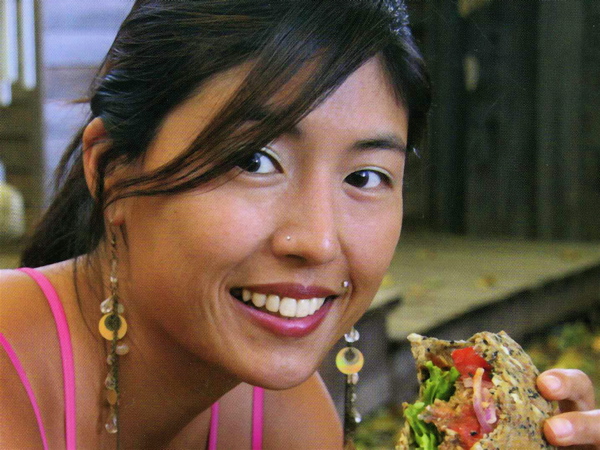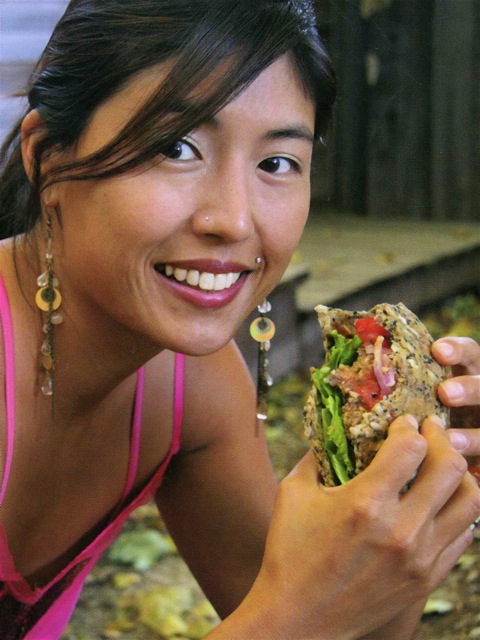
reference-image, l
(article, Miriam Wolf)
[%pageBreakSettings maxWords=900] p(blue). A decade ago, Ani Phyo co-founded Smart Monkey Foods, a company whose healthy snack bars are simultaneously organic, vegan, and raw. The raw-foods movement (also known as the living-foods movement) advocates eating only fresh foods not cooked above 116 degrees. Along with packaged foods such as Smart Monkey's bars, there are raw-food restaurants and raw-food cookbooks, including Phyo's new book, Ani's Raw Food Kitchen. The book offers simple raw-food recipes for both longtime adherents and raw-food newbies. How long have you been eating a raw-food diet? I grew up on a lot of raw foods. My mother had an organic garden and she used to make us vegetable juices that were filled with everything she thought was good for us. They were a brown sludge; my brother and I would have to hold our noses to drink them. My father was into raw foods, too; I would watch him eating bell peppers like they were apples. I always just thought it was a habit from the old country; I thought, "Oh, he’s so unsophisticated." Now, when I look back, I realize he was actually mono-dieting — eating good food really simply. When I got to college and I was on my own, I started eating all this food that I never really had around me when I was younger. And I gained weight, developed cholesterol issues, all that stuff. [%image ani float=left width=300 caption="Ani Phyo, as pictured on the front of her cookbook." credit="Photo: Ede Schweizer"] Then, in the early 1990s, I was living in San Francisco and I went to the raw restaurant run by Juliano \[who now owns Juliano’s Raw in Santa Monica, California\]. I fell in love with the food. When I ate Juliano’s food, I could stay up all night. The more I ate that way, the more energy I had. I wouldn’t get sick, even though I wasn’t sleeping one night a week. And it was really delicious. I started getting into preparing it myself, and eventually ended up working there. Me going 100 percent raw vegan, that was over a period of seven years. People who eat raw diets often say it gives them more energy. Why does eating raw foods make people feel so full of vitality? First of all, because it’s lighter. The analogy that I use is that when I think about white flour, I remember I used to use it to make papier-mâché. It’s a paste of white flour and water. And that’s also the mixture they use to stick concert posters up on construction walls and things. I just think when I’m taking that in — like, a piece of bread — it just takes a lot of energy for my body to process that and pass it through, because it’s really like a paste going through the system. But when we’re eating fresh organic produce, it’s just water and fiber. There’s so much water in raw food. Our bodies are like 70 percent water; produce is like 70 or 80 percent water. Another reason is that there are no fillers; it’s nutrient-dense food with the minerals and vitamins and nutrients that we need. So we’re getting all this nutrition, and that gives us energy, too. And because the food is not heated, the enzymes are active; the enzymes are what ripen the banana, what help break it down. The enzymes help break the food down in your body, too. What are your thoughts on transitioning to a raw diet? It's easy to be raw in southern California, where there are tons of places to get raw food. I really feel like \[Californians\] are the people who don’t need the help right now. But there are so many people right now who aren’t in good health, or maybe the toxicity levels in their bodies are caused by the preservatives, colors, and other toxic chemicals that are in our food supply and in our air. Those are the people I really want to help. Recently I was at a raw festival down in southern California, and a very, very overweight woman came up and told me, “I found your book, I found your website, I came here by myself because nobody would come with me. I just had to come and see you because I just lost my husband to colon cancer and my doctor’s telling me I can’t eat all these things that I eat all the time. I don’t know what I can eat.” She was in crisis mode. I talked with her for a while and I walked her around to the different booths. She ate vegan, raw organic food for the first time, and she was flipping out! She was like, “This is vegan? This is raw? This is so good.” Her whole world expanded with all these options. Nobody had ever shown her that before. I think that a lot of people, when they develop health issues, are like, “Oh, I can’t eat this thing that I’ve always eaten," and they kind of freak out. I help them by saying, “OK, so you want to eat a burger and fries? Go ahead and eat a burger and fries. But here, have this giant salad first, because the fiber and the water will fill you up, and there are nutrients in it because it’s organic, so you’ll give the body the nutrition it needs with no fillers, and you’ll feel more satisfied." What happens all the time is that they’ll eat maybe half of \[the burger and fries\]. Do most raw foodies eat 100 percent raw food? I don’t think so. I think being able to eat 100 percent raw food really depends on your climate, your location, your lifestyle. Unless you’re making your own food all the time, which some people don’t really have time for. Even \[raw guru\] David Wolfe and people like that are saying, "Eat 80 percent raw." Some people even say 50 percent raw. It’s kind of difficult to be 100 percent raw in our world with our lifestyle. But I think there are concentrations. In southern California, there are definitely 110 percent raw fooders — like, extreme raw fooders. But you’re in a hot sunny climate with lots of organic farmers' markets. For somebody in Toronto, it’s not realistic. I’m not 100 percent raw anymore. I used to be, when I lived in southern California. When I lived up in Portland, \[Oregon\], my house was 100 percent raw, but there were no raw restaurants, and there’s no place to go and get raw. Unless we did the raw, there was no raw. We’d do classes at Whole Foods. Sometimes I’d get tired of eating my own food, but we’d have potlucks at our house, and other people would bring their foods so I could eat other people’s foods. But it was hard to ever go out anywhere. [[block(sidebar). h1. Phyo on video Watch Ani Phyo demonstrate her dolmas recipe on YouTube. ]] Also, I was getting so much energy off of it that I wasn’t balanced in my life. I was working working working all the time; I was super-productive and I got tons of work done. I’d never get sick and I could just go go go go, but after doing that for so many years, I think I depleted my body overall. Because there needs to be balance. For me, I needed to ground a little bit and catch up on rest. Can you talk a little about how raw-food diets fit into environmentalism? The way I look at it, being green is a whole lifestyle. From the moment I went 100 percent raw, I noticed that all the garbage in my kitchen went away. A lot of the garbage we generate is usually the packaging from prepared foods. When we go to the farmers' market now, we buy in bulk, we take our own containers, we reuse our plastic bags, we’re not using packaging. So that’s decreasing our output a lot. All we’re making when we prepare our food now is organic compost. Can you adopt a raw diet without spending your life chopping, juicing, dehydrating, and otherwise spending hours each day preparing food? Or is that just part of the territory? It’s not, and that’s why I wrote my book. My raw-food system is all about that, because I came from that background most of my adult life. When we used to do our weekly dinners, it used to take me four or five days to prepare food. Soaking, seasoning, dehydrating — all this stuff was complex. But I’ve learned that the fewer ingredients you use, the more each ingredient's flavor can actually stand out. So you’ll notice in my book that there are only a handful of ingredients for each recipe. And all the recipes are for quick chopping, or throwing some ingredients in a blender for 30 seconds and it’s done. When I come back from the farmers' market, I’ll just wash everything all at once, put it in the fridge, and make a huge jar of dressing. Now, whenever I’m hungry, I can just run to the fridge, grab a handful of already-made salad mix, and throw it on a plate. I already have the dressing, so I just pour it over. Now how long does that take? Like two seconds. There are some staples that, if you make them and have them in the fridge all the time, you have the basics. It’s just a matter of knowing how to do that, setting it up, and then getting into that rhythm. [[block(sidebar). h1.Featured recipes]] Do you have a favorite recipe from your book? I have several. But one of them is the Mediterranean dolmas. You don’t have to do anything; it’s sundried tomatoes, pine nuts, raisins, and dill. You just put it into a bowl and drizzle a little olive oil over it. And then you just spoon it into whatever leaf you want, and you just roll it up. If I’m traveling or making food for someone, or even if I’m at a store doing a demo on a little table, I usually do that one, because it's so easy. And then, flavorwise, I just love my mango cobbler. p(bio). Miriam Wolf writes about food and books for various publications. She is also the managing editor of Bitch magazine.

reference-image, l

promo-image, l

ani, l